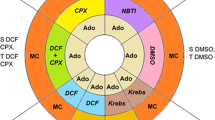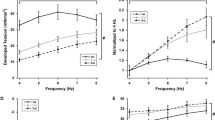Abstract
The present study was undertaken to compare the effects of hypothyroidism and hyperthyroidism on sarcoplasmic reticulum (SR) Ca2+-pump activity, together with assessment of the functional role of SR in providing activator Ca2+ under these altered thyroid states. In response to a shift from hypothyroid to hyperthyroid state, a 10 fold and 2 fold increase in SR Ca2+-pump activity in atria and ventricles, respectively, were observed. This was associated with the 8-9 fold increases in atrial contractility (+dT/dt) and relaxation (-dT/dt), but only with a 3-4 fold increase in their ventricular counterparts. Also, the recirculation fraction of activator Ca2+ (RFA) increased to a far greater extent in atria (4 fold) than in papillary muscles, and the relative increment in inhibition of developed tension by ryanodine became 3 times larger in atria than in papillary muscles. A positive force-frequency relationship (FFR) was observed in hypothyroid atria, whereas the hyperthyroid atria, hypothyroid and hyperthyroid papillary muscles showed a negative FFR. These results suggest the greater role of transsarcolemmal (SL) Ca2+ and smaller role of SR Ca2+ in activating contraction in hypothyroid atria compared to other preparations. Thyroid hormones decrease the contribution of SL and increase that of SR in providing activator Ca2+ to the greater extent in atria than in ventricles. This effect of thyroid hormones is based on larger stimulation of SR Ca2+-pump in atria compared to ventricles.
Similar content being viewed by others
References
Fabiato A: Calcium-induced release of calcium from the cardiac sarco-plasmic reticulum. Am J Physiol 245: C1–C14, 1983
Bers DM: Control of cardiac contraction by SR Ca release and sarco-lemmal Ca fluxes. In: Developments in Cardiovascular Medicine. Kluwer Academic Publishers, Netherlands, 122: 149–170, 1991
Baudet S, Noireaud J, Léoty C: Effect of haemodynamic pressure over-load of the adult ferret ventricle on inotropic responsiveness to external calcium and rest periods. Pflugers Arch 420: 603–610, 1992
Bers DM, Bassani RA, Bassani JWM, Baudet S, Hryshko LV: Paradoxical twitch potentiation after rest in cardiac muscle: increased fractional release of SR calcium. J Mol Cell Cardiol 25: 1047–1057, 1993
Vornanen M: Force-frequency relationship, contraction duration and recirculating fraction of calcium in postnatally developing rat heart ventricles: correlation with the heart rate. Acta Physiol Scand 145: 311–321, 1992
Nagai R, Zarain-Herzberg A, Brandl CJ, Fujii J, Tada M, MacLennan DH, Alpert NR, Periasamy M: Regulation of myocardial Ca2+-ATPase and phospholamban mRNA expression in response to pressure overload and thyroid hormone. Proc Natl Acad Sci USA 86: 2966–2970, 1989
Kimura Y, Otsu K, Nishida K, Kuzuya T, Tada M: Thyroid hormone enhances Ca2+ pumping activity of the cardiac sarcoplasmic reticulum by increasing Ca2+ ATPase and decreasing phospholamban expression. J Mol Cell Cardiol 26: 1145–1154, 1994
Kiss E, Jakab G, Kranias EG, Edes I: Thyroid hormone-induced alterations in phospholamban protein expression. Regulatory effects of sarcoplasmic reticulum Ca2+ transport and myocardial relaxation. Circ Res 75: 245–251, 1994
Kolár F, Seppet EK, Vetter R, Procházka J, Grünermel J, Zilmer K, Oštádal B: Thyroid control of contractile function and calcium handling in neonatal rat heart. Pflügers Arch 421: 26–31, 1992
Vetter R, Kott M: Reciprocal changes in SR Ca transport and Na/Ca exchange in the immature rat heart due to altered thyroid status. J Mol Cell Cardiol 27: A86, 1995
Bossen EH, Sommer JR, Waugh RA: Comparative stereology of mouse atria. Tissue Cell 13: 71–77, 1981
Forbes MS, Van Niel EE: Membrane systems of guinea-pig myocardium: Ultrastructure and morphometric studies. Anat Rec 222: 362–379, 1988
Koss KL, Ponniah S, Jones WK, Grupp IL, Kranias EG: Differential phospholamban gene expression in murine cardiac compartments. Molecular and physiological analyses. Circ Res 77: 342–353, 1995
Everett AW, Clark WA, Chizzonite RA, Zak R: Change in synthesis rates of alpha-and beta-myosin heavy chains in rabbit heart after treatment with thyroid hormone. J Biol Chem 258: 2421–2425, 1983
Banerjee SK: Comparative studies of atrial and ventricular myosin from normal, thyrotoxic, and thyroidectomized rabbits. Circ Res 52: 131–136, 1983
Chizzonite RA, Everett AW, Prior G, Zak R: Comparison of myosin heavy chains in atria and ventricles from hyperthyroid, hypothyroid, and euthyroid rabbits. J Biol Chem 259: 15564–15571, 1984
Samuel J-L, Rappaport L, Syrovy I, Wisnewsky C, Marotte F, Whalen RG, Swartz K: Differential effect of thyroxine on atrial and ventricular myosin in rats. Am J Physiol 250: H333–H341, 1986
Kaasik A, Seppet EK, Ohisalo JJ: Enhanced negative inotropic effect of an adenosine A1-receptor agonist in rat left atria in hypothyroidism. J Mol Cell Cardiol 26: 509–517, 1994
Chijiwa T, Mishima A, Hagiwara M, Sano M, Hayashi K, Inoue T, Naito K, Toshioka T, Hidaka H: Inhibition of forskolin-induced neurite outgrowth and protein phosphorylation by a newly synthesized selective inhibitor of cyclic AMP-dependent protein kinase, N-[2-(p-bromocinnamylamino) ethyl]-5isoquinolinesulfonamide (H-89), of PC12D pheochromocytoma cells. J Biol Chem 265: 5267–5272, 1990
Morad M, Goldman Y: Excitation-contraction coupling in heart muscle: membrane control of development of tension. Prog Biophys Mol Biol 27: 257313, 1975
Urthaler F, Walker AA, Reeves DNS, Hefner LL: Maximal twitch tension in intact length-clamped ferret papillary muscles evoked by modified postextrasystolic potentiation. Cir Res 62: 65–74, 1988
Urthaler F, Walker AA, Reeves DNS, Hefner LL: Excitation-contraction coupling model to estimate the resirculaton fraction of activator calcium in intact cadiac muscle. Can J Physol Pharmacol 68: 1041–1048, 1990
Wohlfart B: Relationship between peak force, action potential duration and stimulus interval in rabbit myocardium. Acta Physiol Scand 106: 395–409, 1979
Solaro RJ, Briggs FN: Estimating the functional capabilities of sarcoplasmic reticulum in cardiac muscle. Circ Res 34: 531–540, 1974
Alpert NR, Mulieri LA, Blanchard E, Litten RZ, Holubarsch C: A myotermal analysis of absolute myosin crossbridge cycling rates in rat hearts. In: Muscle Energetics. Alan R. Liss Inc, 1989, pp 503–527
Buccino RA, Spann Jr JF, Pool PE, Braunwald E: Influence of the thyroid state on the intrinsic contractile properties and energy stores of the myocardium. J Clin Invest 46: 1682–1699, 1967
Korecky B, Zak R, Schwartz K, Aschenbrenner V: Role of thyroid hormone in regulation of isomyosin composition, contractility, and size of heterotopically isotransplanted rat heart. Circ Res 60: 824–830, 1987
Seppet EK, Kolar F, Dixon IMC, Hata T, Dhalla NS: Regulation of cardiac sarcolemmal Ca2+ channels and Ca2+ transporters by thyroid hormone. Mol Cell Biochem 129: 145–159, 1993
Gay RG, Raya TE, Lancaster LD, Lee RW, Morkin E, Goldman V: Effects of thyroid state on venous compliance and left ventricular performance in rats. Am J Physiol 254: H81–H88, 1988
Koch-Weser J, Blinks JR: The influence of the interval between beats on myocardial contractility. Pharmacol Rev 15: 601–652, 1963
Benforado JM: Frequency-dependent pharmacological and physiological effects on the rat ventricle strip. J Pharmacol Exp Ther 122: 86–100, 1958
Stemmer P, Akera T: Concealed positive force-frequency relationships in rat and mouse cardiac muscle revealed by ryanodine. Am J Physiol 251: H1106–H1110, 1986
Osty J, Rappaport L, Samuel JL, Lennon AM: Characterization of a cytosolic triiodothyronine binding protein in atrium and ventricle of rat heart with different sensitivity toward thyroid hormone levels. Endocrinology 122: 1027–1033, 1988
Arai M, Otsu K, MacLennan DH, Alpert NR, Periasamy M: Effect of thyroid hormone on the expression of mRNA encoding sarcoplasmic reticulum proteins. Circ Res 69: 266–276, 1991
Colyer J: Control of the calcium pump of cardiac sarcoplasmic reticulum. A specific role for the pentameric structure of phospholamban? Cardiovasc Res 27: 1766–1771, 1993
Luo W, Grupp IL, Harrer J, Ponniah S, Grupp G, Duffy JJ, Doetschman T, Kranias EG: Targeted ablation of the phospholamban gene is associated with markedly enhanced myocardial contractility and loss of β-stimulation. Circ Res 75: 401–409, 1994
Beekman RE, van Hardeveld C, Simonides WS: Thyroid status and β-agonistic effects on cytosolic calcium concentration in single rat cardiac myocytes activated by electrical stimulation or high-K+ depolarization. Biochem J 268: 563–569, 1990
Gwathmey JK, Hajjar RJ: Intracellular calcium related to force development in twitch contraction of mammal myocardium. Cell Calcium 11: 531–538, 1990
MacKinnon R, Morgan JP: Influence of the thyroid state on the calcium transient in ventricular muscle. Pflügers Arch 407: 142–144, 1986
Suko J: Alterations of Ca2+-uptake and Ca2+-activated ATPase of cardiac sarcoplasmic reticulum in hyper-and hypothyroidism. Biochem Biophys Acta 252: 324–327, 1971
Asgrimsson H, Johannson M, Arnardottir SA: Excitation and contraction in atrial and ventricular myocardium of the guinea-pig. Acta Physiol Scand 153: 133–141, 1995
Shimoni Y, Banno H, Clark RB: Hyperthyroidism selectively modifies a transient potassium current in rabbit ventricular and atrial myocytes. J Physiol 457: 369–389, 1992
Shimoni Y, Banno H: Thyroxine effects on temperature dependence of ionic currents in single rabbit cardiac myocytes. Am J Physiol 265: H1875–H1883, 1993
Author information
Authors and Affiliations
Rights and permissions
About this article
Cite this article
Kaasik, A., Minajeva, A., Paju, K. et al. Thyroid hormones differentially affect sarcoplasmic reticulum function in rat atria and ventricles. Mol Cell Biochem 176, 119–126 (1997). https://doi.org/10.1023/A:1006887231150
Issue Date:
DOI: https://doi.org/10.1023/A:1006887231150




